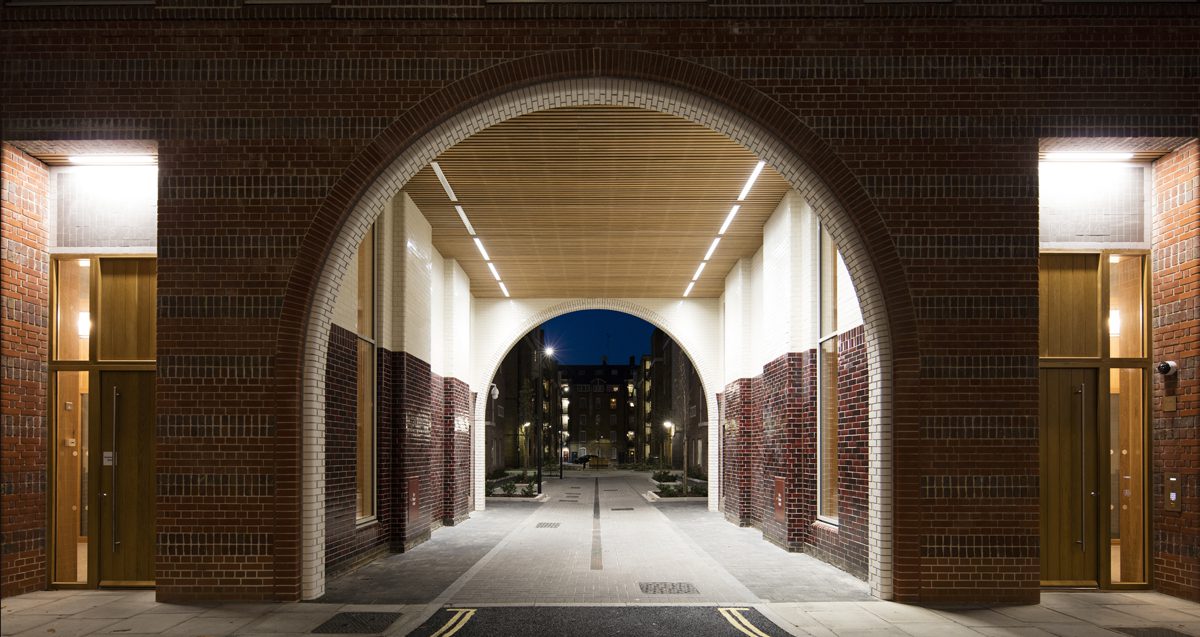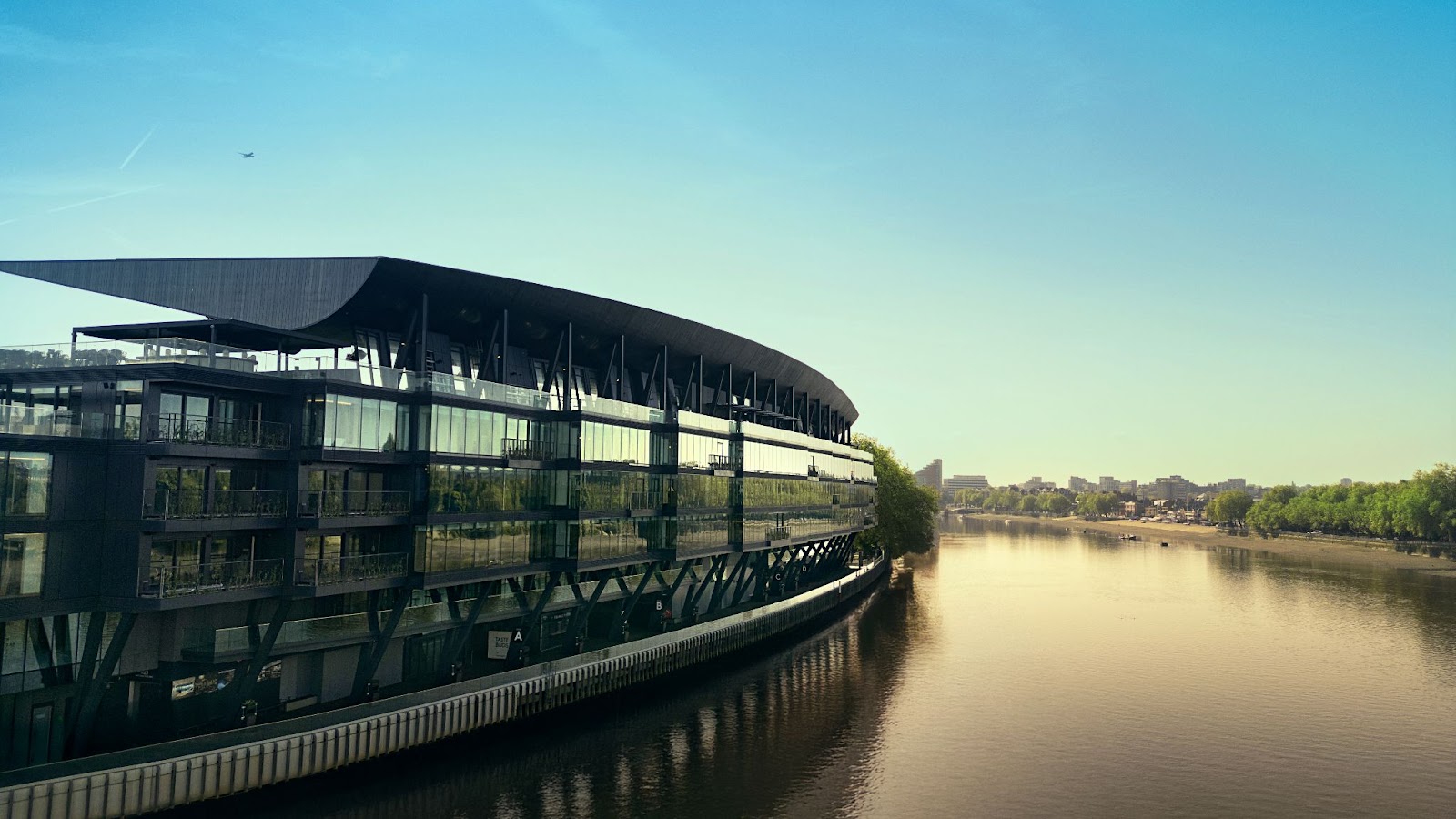Two buildings by Matthew Lloyd Architects make sympathetic reference to a landmark London housing estate, finds Sally Lewis
Two residential blocks that Matthew Lloyd Architects has added to the Bourne Estate nestle comfortably into an established neighbourhood, paying tribute to the fabric of the Edwardian tenements while injecting a contemporary charm to this piece of London, between the jewellery district of Hatton Garden and the legal precincts of Gray’s Inn.
The scheme provides 75 residential units in a mix of tenures, including both social rent and private sale, and a new community hall together with improved public realm and landscaping. Sitting partially within the Hatton Garden Conservation Area, and built in 1901-1903, the grade II-listed estate is a key example of early innovative London County Council housing schemes, that have parallels in the influential public housing of pre-war Vienna.
Block Two completes an existing court
Its extension is a Camden Council-led project initiated in 2012 and completed in 2017 – a long journey with fine outcomes. The project’s main move is to complete the existing urban blocks and create an open communal courtyard linking a school, the existing estate, and the new homes. Block One turns a corner on Verulam Street and Portpool Lane, on the site of a multi-use games area which has been relocated.
Block Two, on Baldwin’s Gardens, replaces a tired post-war apartment building and is organised to complete a long courtyard inside the estate. An understated but powerful urban design gesture, the scheme blends old and new without any overt tendency to the pastiche. Its performance in broad townscape terms cannot be faulted.
Equally successful is the celebration of each front door, and the consideration given to the journey of the pedestrian from the street and square to the interior of the apartment. The materials in the stairwells and corridors are rich in their pattern and texture: glazed tiles combined with slatted oak ceilings, bespoke steel handrails, and large front doors in dark timber. Window seats in the entrance areas invite a pause along the journey, and open stairs and access corridors offer ‘fresh air’ all the way to the front door. This is a brave departure from the standard fare offered by speculative housing, with common areas usually bland, impersonal and merely fit for purpose.
This point reveals that local authorities have the means to offer a different prospect of ‘home’ to their residents, and can stand apart from the speculative housebuilder who is more concerned with net internal floor areas bringing a direct financial return.
Stairwells and access corridors are finished with robust but attractive materials including oak slats and ceramic tile
At the Bourne Estate the client and architect have worked together to push through quality in the more public areas, with materials that will not only stand the test of time, but also offer a distinctive charm and identity by tapping into the details of local heritage. The wonderful brick arches leading into the courtyards speak of the estate’s character and have a level of decoration appropriate to their form and material. Elsewhere the choice of decorative elements is less successful, with the ground floor collection of doors and entrances facing the street lacking coherence in their composition. The detailing along the deck soffit edges to the courtyard could have been resolved with a cleaner approach, lending the elevation a more robust expression in these areas.
In consultation, residents requested new entrance arches in the spirit of the existing estate, and the design for access to flats centres around a contemporary interpretation of the original open-air balconies
The project opens up questions about the role of decoration and the crafting of facades in the context of the increasingly dominant ‘New London Vernacular’. Now that lovely bricks and large windows are again de rigeur, we increasingly look beyond these fundamental features for local distinction and flavour in housing projects. The main gesture of this scheme is to employ imported tiles on the facades, alongside a range of brick tones and bonds used to bring individual expression to the various forms. Akin to the London Underground glazed tile, these ceramic linings give a fine texture which has been proven to be robust in gritty urban contexts, and lend a sense of quality and longevity.
Crisp, clean balconies with no sign of offending downpipes provide sculptural relief to the facades, but their steel balustrades offer little privacy to any resident wishing to enjoy the outdoors in their own dedicated amenity space. Provision of external private amenity space for every home is one of the hallmarks of the housing space standards outlined in the London Plan, and it is always a design challenge to balance the various roles of the balcony: enlivening facades and providing surveillance over streets and squares, as well as extending living space into a reasonably private external space. One hopes that residents will respect the pristine disposition of the Bourne Estate balconies, but there is of course a risk that those with little regard for the tidiness of the facade will be inclined to install screening behind the open railings.
Following the mantra for good urban design, the scheme generally makes clear distinctions between public and private space. Blurring of these lines takes place on the access decks which could potentially be colonised by the adjacent home in the same way as happens in the existing estate, but their relatively austere design does not issue any invitation to do so. How the scheme will be used by residents from the inside out is less clear than the rich experience of the journey from the outside in.
As a celebration of brick and local heritage, this scheme will no doubt age gracefully and become home to a diverse community in the tradition of the Bourne Estate. Local authorities across London are working hard to deliver housing on their own land, and the years to come could be marked as a time of housing innovation with the public sector leading the way and creating new legacies for the future. Any local authority with these aspirations should take a visit to Matthew Lloyd Architects’ work at the Bourne Estate.
Additional Images
Credits
Architect
Matthew Lloyd Architects
Structural engineers
Campbell Reith, Walker Associates
M&E engineer
TGA Consultants, Higgins
Project manager
CPC Project Services
Main contractor
Higgins Construction
Client
London Borough of Camden
Landscape architect
Dally Henderson, MCA
Bricks
Just Facades, Freshfield Lane, All About Bricks, Ibstock
Glazed brick tiles
Craven Dunhill
Timber Soffits
BCL Timber Projects
Louvred doors
Sunray
Stairs
Abbeycrete































